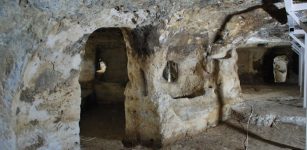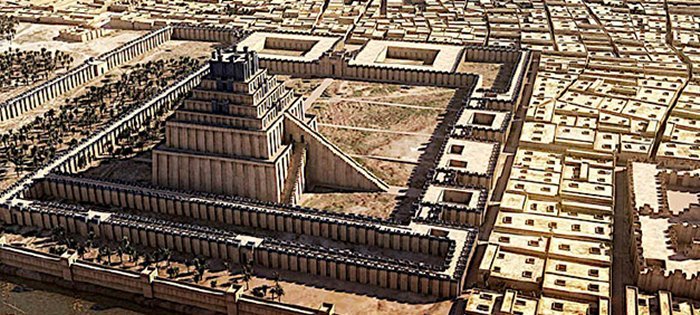Ziggurats, Axis Mundi And Strong Connection To Religion In Mesopotamia
A. Sutherland - AncientPages.com - The ancient civilization of the Sumer still hides many secrets. Representatives of this unique culture left behind many art pieces, pottery, writing hydraulic engineering, and monumental ziggurats, which were artificial mountains of sunbaked brick with outside staircases that tapered toward a shrine at the top.
The Sumerian tradition of building ziggurats was adopted by other Mesopotamia civilizations such as the Akkadians, the Babylonians, and the Assyrians.
The ziggurat, according to the Sumerians, was a cosmic axis. As Mircea Eliade (1907-1986), a Romanian historian of religion, philosopher, and professor at the University of Chicago, maintained, the Sumerians tried to live in the presence of the sacred because they "desired access to the ultimate reality and the power of the sacred."
The Axis Mundi, the vertical feature, was considered the center of the world that linked all three cosmic levels. Instead of a tree, pole, or pillar, the Axia Mundi might be "a ladder or a mountain." Beliefs in heavenly mountains included the idea that 'our world' is holy because it is the place closest to heaven. Eliade suggested that temples might be seen as equivalents of sacred mountains. Indeed, some, such as the Babylonian ziggurat, were built to be artificial holy mountains.
The ziggurat design ranges from a simple base with a small temple on top to large and complex structures decorated with terraces topped with a temple. The base could be rectangular, square, or oval, and the core of the ziggurat was constructed of sun-dried bricks (adobe), while the outer part was lined with fired bricks that could also be vitrified in different colors.
Platforms around the stairs were often adorned with plants and trees to symbolize a man-made mountain.
So, in what sense was a ziggurat an example of Axis Mundi?
The historical site was built upon the order of Untash-Napirisha, king of Elam. Image source
It was believed that it is a physical center of the universe, a temporal center of the universe, and a mediation place between heaven and earth. The priests had access to the ziggurat via stairs located on the building's sides or spiraling up to the top.
One of the best-preserved ziggurats of antiquity is the Elamite Chogha Zanbil structure situated between present-day Iran and Iraq.
The structure was massive, with rooms inside, subterranean royal tombs, and royal palaces. After Untash-Napirisha's death, the site was not abandoned but still occupied until king Ashurbanipal finally destroyed it in 640 BC.
An interesting question is: why did King Untash-Napirisha want to build such an enormous structure? Did he want to create a new religious center to replace Susa?
A simple ziggurat is the White Temple of Uruk, which was dedicated to God Anu, and located in the sacred precinct of Kullaba at Uruk.
Etemenanki (now reconstructed in the Pergamon Museum, Berlin) has been long suggested as a possible inspiration to the biblical story of the Tower of Babel. source
Another example of a large and complex ziggurat is the one found in the ancient city of Babylon and dedicated to Marduk, the son of the mighty god Enki, creator and protector of humanity, patron of craftsmen. It is known as Etemenanki (É.TEMEN.AN.KI "temple of the foundation of heaven and earth") approx. Ninety kilometers (56 mi) south of Baghdad, Iraq. Unfortunately, not much has been left of this ancient structure, even at the ground level.
Using historical sources and modern archaeological surveys, archaeologists reconstruct the building. Now it is known that it had seven levels painted in different colors. On the top of it, it was a beautiful temple to which led three stairs.
During the Sumerian empire's rise, the most characteristic religious building was the ziggurat was built by King Ur-Nammu, and dedicated to Nanna/Sîn in approx. The 21st century BC during the Third Dynasty of Ur. It was a massive step pyramid measured 45 m (148 ft) in width, 64 m (210 ft) in length, and over 30 m (98 ft) in height.
Ziggurats and people's strong connection to religion
Ziggurats and temples were of great importance to the people of Mesopotamia. Each ziggurat was the seat of a different god. The ancient belief that gods dwelled on the distant mountaintop initiated the rise of ziggurats. The word "ziggurat" originates from the Assyrian for "raised " or "high."
In the center of the city, extraordinary, monumental structures were built that symbolized the connection between heaven and earth. The purpose of these large structures was purely religious.
A ziggurat was neither a public place for meetings and ceremonies organized by ordinary people nor any place for quiet contemplation as churches usually are. It was the abode of the gods, an untouchable sacred place. Only the priests (responsible for caring for the gods) had access to the ziggurat's interior.
Each city had its patron god, temple, or a ziggurat, that symbolically connected earth and its people with gods in heaven and created a bridge between earth and the underworld.
Seven levels, seven heavens, seven heavenly bodies
Seven levels of the ziggurat symbolized seven heavens, also understood as seven planes of existence. The number "seven" was apparently of great importance; there were seven heavenly bodies and related to the seven metals known to ancient people (gold, silver, copper, iron, mercury, tin, and lead).
 Ancient ziggurat of Aqar Quf dedicated to god Enlil. source
Ancient ziggurat of Aqar Quf dedicated to god Enlil. source
The prototype of ziggurats was a high terrace on which the temple was erected. Such a structure was found in many Sumerian cult circles between 4000 BC -3000 BC.
The classic form of ziggurats links to the reign of the rulers of the 3rd dynasty from Ur (c. 2100-2000 BC). Later, the ziggurat's layout changed, as it had a rectangular base, three floors, and three rows of stairs on the side of the facade. In the 2nd millennium BC, ziggurats were erected in a Mesopotamian kingdom of Assyria and Elam in southwestern Iran.
In Mesopotamia, it was much about maintaining balance in the world and keep the forces of chaos and destruction away. Through attention to the deities, daily rituals, and proper funeral practices, the people of Mesopotamia believed they could live in peace with gods and themselves.
Approximately twenty-five ziggurats have been revealed in various forms of deterioration between Sumer, Assyria, and Babylon.
Written by – A. Sutherland - AncientPages.com Senior Staff Writer
Copyright © AncientPages.com All rights reserved. This material may not be published, broadcast, rewritten or redistributed in whole or part without the express written permission of AncientPages.com
Expand for referencesReferences:
History, Captivating. Sumerians: A Captivating Guide to Ancient Sumerian History
More From Ancient Pages
-
 Is ‘Someone’ Regularly Altering The Course Of History? – Unexplained Events – Part 2
Ancient Mysteries | Dec 3, 2020
Is ‘Someone’ Regularly Altering The Course Of History? – Unexplained Events – Part 2
Ancient Mysteries | Dec 3, 2020 -
 Huge, Ancient Underground City Filled With Artifacts Discovered In Mardin, Turkey
Archaeology | Apr 20, 2022
Huge, Ancient Underground City Filled With Artifacts Discovered In Mardin, Turkey
Archaeology | Apr 20, 2022 -
 10,000-Year-Old Seeds Offer First Evidence Of Farming In A Green Sahara
Archaeology | Mar 19, 2018
10,000-Year-Old Seeds Offer First Evidence Of Farming In A Green Sahara
Archaeology | Mar 19, 2018 -
 Suontaka Weapon Grave: New Light On Strong Female Leaders And Warriors Of Late Iron Age Finland
Archaeology | Jul 29, 2021
Suontaka Weapon Grave: New Light On Strong Female Leaders And Warriors Of Late Iron Age Finland
Archaeology | Jul 29, 2021 -
 On This Day In History: Taoist Monk Discovers Dunhuang Manuscripts In Mogao Caves, China – On June 25, 1900
News | Jun 25, 2016
On This Day In History: Taoist Monk Discovers Dunhuang Manuscripts In Mogao Caves, China – On June 25, 1900
News | Jun 25, 2016 -
 Burials Of An Unknown Race Of Unusually Small Humanoids Found In Ohio May Confirm Native American Legend
Featured Stories | Aug 18, 2024
Burials Of An Unknown Race Of Unusually Small Humanoids Found In Ohio May Confirm Native American Legend
Featured Stories | Aug 18, 2024 -
 Unexplained Encounters With A Mysterious Being In South Dakota Reported – Why Is This Happening?
Featured Stories | Jul 9, 2024
Unexplained Encounters With A Mysterious Being In South Dakota Reported – Why Is This Happening?
Featured Stories | Jul 9, 2024 -
 Startling Roman-Looking Sandal Discovered Buried Deep Beneath The Snow In Norwegian Mountains
Archaeology | Apr 13, 2022
Startling Roman-Looking Sandal Discovered Buried Deep Beneath The Snow In Norwegian Mountains
Archaeology | Apr 13, 2022 -
 Rare And Unusual Post-Medieval Lead Doll Found In Long Whatton, UK By Mudlarker
Archaeology | Jun 24, 2024
Rare And Unusual Post-Medieval Lead Doll Found In Long Whatton, UK By Mudlarker
Archaeology | Jun 24, 2024 -
 Another Franklin Expedition Crew Member Identified
Archaeology | Sep 26, 2024
Another Franklin Expedition Crew Member Identified
Archaeology | Sep 26, 2024 -
 Scientists Unravel The Mystery Of The Alexander Sawney Bean Legend & Cave-Dwelling Cannibals In Scotland
Myths & Legends | Sep 24, 2015
Scientists Unravel The Mystery Of The Alexander Sawney Bean Legend & Cave-Dwelling Cannibals In Scotland
Myths & Legends | Sep 24, 2015 -
 Harappan Civilization Built Massive Protection Walls Against Tsunami 5,000 Years Ago
Archaeology | Jan 10, 2017
Harappan Civilization Built Massive Protection Walls Against Tsunami 5,000 Years Ago
Archaeology | Jan 10, 2017 -
 Ancient City Of Prusias ad Hypium And Ruins Of City’s Theater Known As ’40 Steps’
Archaeology | Mar 13, 2020
Ancient City Of Prusias ad Hypium And Ruins Of City’s Theater Known As ’40 Steps’
Archaeology | Mar 13, 2020 -
 Sun: Highest Cosmic Power Worshiped By Ancient People And Represented By Deities
Featured Stories | Apr 1, 2019
Sun: Highest Cosmic Power Worshiped By Ancient People And Represented By Deities
Featured Stories | Apr 1, 2019 -
 Inscription At Aquae Calidae Sheds Light On Last Years Of Ancient Thrace’s History
News | Aug 30, 2015
Inscription At Aquae Calidae Sheds Light On Last Years Of Ancient Thrace’s History
News | Aug 30, 2015 -
 India’s Mysterious Stonehenge: Prehistoric Complex Of Gigantic Standing Stones Of Willong Is An Enigma
Featured Stories | Jul 30, 2016
India’s Mysterious Stonehenge: Prehistoric Complex Of Gigantic Standing Stones Of Willong Is An Enigma
Featured Stories | Jul 30, 2016 -
 Terrace Farming Was Invented In South American Andes Over 1,000 Years Ago
Ancient History Facts | Sep 7, 2016
Terrace Farming Was Invented In South American Andes Over 1,000 Years Ago
Ancient History Facts | Sep 7, 2016 -
 How And When Did Ancient People Start Using Oil?
Ancient History Facts | Jun 28, 2018
How And When Did Ancient People Start Using Oil?
Ancient History Facts | Jun 28, 2018 -
 On This Day In History: Johannes Kepler ‘Father Of Modern Astronomy’ Was Born – On Dec 27, 1571
News | Dec 27, 2016
On This Day In History: Johannes Kepler ‘Father Of Modern Astronomy’ Was Born – On Dec 27, 1571
News | Dec 27, 2016 -
 Mysterious Grave Of King Valdemar IV Atterdag – Will The 600-Year-Old Historical Puzzle Ever Be Solved?
Featured Stories | Jul 14, 2018
Mysterious Grave Of King Valdemar IV Atterdag – Will The 600-Year-Old Historical Puzzle Ever Be Solved?
Featured Stories | Jul 14, 2018




